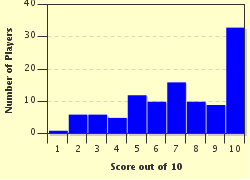Quiz Answer Key and Fun Facts
1. I enter my Bikram Yoga class for the first time and I am greeted by my teacher with the word, "Namaste". Puzzled, I ask her the meaning of namaste. She told me and now I want to share it with you. What is the literal meaning of "namaste"?
2. My teacher of Bikram Yoga, who is a soft spoken woman, introduces herself to me. What term is often used for a female teacher of yoga?
3. Upon entering the classroom I was overwhelmed with the heat. I knew when I signed up for a Bikram Yoga class that it would be performed in a very warm room. The room I was in has been heated to 105F and has 40 percent humidity. I silently wonder if I can stay in this oven? "Is this the same as 'hot yoga'?" I ask of my teacher. With a slight nod of her head she explains it is not and gives the differences. What is one of the differences between hot yoga and Bikram Yoga?
4. Already my hands are perspiring from the heat as I clutch my gear and take the space saved for me. Which three items make up my gear and are essential for each class?
5. As I sit cross-legged on my mat in imitation of my silent but pleasant looking classmates, I notice the wall in front of me. The whole length of the wall is covered and I wonder about this type of covering. With what is the long wall covered?
6. My teacher steps toward the front of the class. We are about to start. But first, she says, in preparation for the postures we will meditate for five minutes. What is something that would NOT be helpful to do during meditation?
7. Motioning us for us to stand, we rise and follow our teacher's instruction. We put our feet together, heels touching. We interlace our fingers, and with elbows bent we place them under our chin. We inhale slowly and raise our elbows toward our ears. The next step is essential to learn in any type practice of yoga. Which of these is that next step?
8. The class is now in the process of trying to do the twenty-six postures that constitute Bikram Yoga. Which of these is not a name for a Bikram pose?
9. Standing Knee Pose, Standing Bow Pulling Pose, and Balancing Stick Pose are all standing postures. It is time for Standing Knee Pose. My teacher has one important instruction to accomplish these poses. What does she tell us to do?
10. I wonder about Bikram Choudhury. I know he is from India. In what city was Bikram Choudhury born?
Source: Author
Irishrosy
This quiz was reviewed by FunTrivia editor
WesleyCrusher before going online.
Any errors found in FunTrivia content are routinely corrected through our feedback system.


